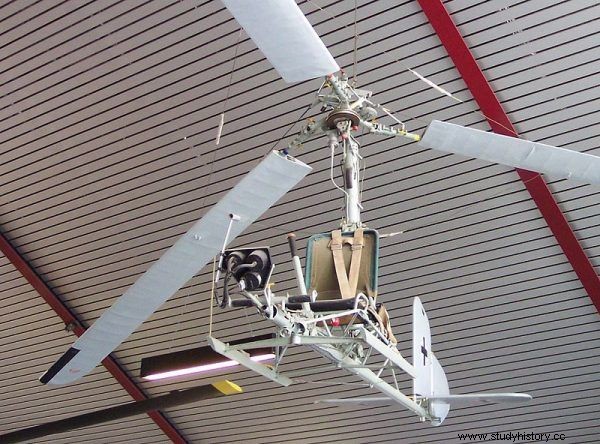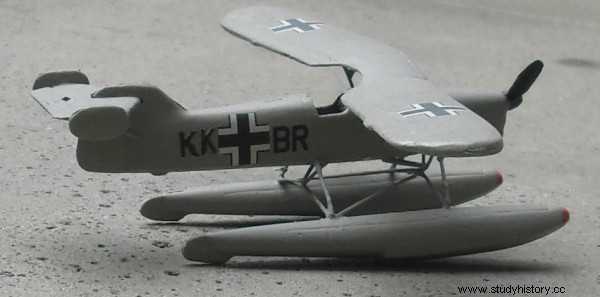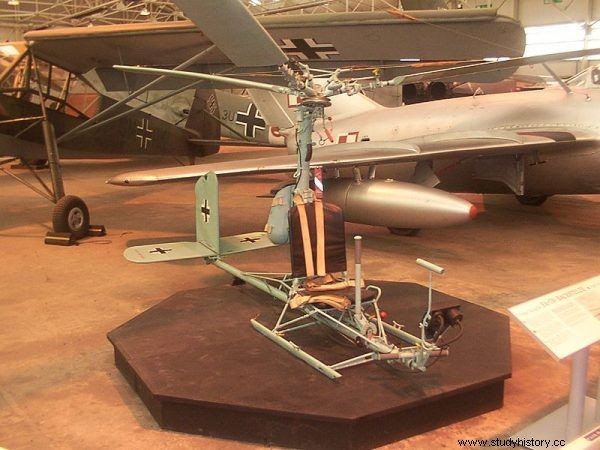"Flying sailors" appeared on board German submarines in the second half of the war. They were trained to pilot an unusual flying machine - a wind glider. The Bachstelze, because that was the name of this invention, could be folded in a few minutes and released on a rope over a flowing u-boat. Why was this technical innovation introduced and how did it work?
Thousands of talented scientists and engineers worked in the Third Reich, and they were allowed to implement the most bizarre ideas, provided that they had military significance and could provide an advantage to the Germans in a planned war. Even before 1939, they conducted research on many innovative, ahead of their time, weapons and technologies that were to support the Wehrmacht, Luftwaffe and Kriegsmarine in combat.
Among their inventions was, for example, the first stable and safe flying helicopter - the Focke-Wulf Fw 61 , constructed as early as 1936. Later, other innovative flying machines appeared, including Jet and rocket planes, rockets, missile planes, guided bombs, large transport gliders, and - at the end of the war - even "flying wing" planes.

Focke-Achgelis FA 330
Among the most unusual solutions proposed and implemented was the Focke-Achgelis Fa 330 "Bachstelze" gyroplane (gray wagtail - a small bird from the wagtail family - editor's note). How did this bizarre machine find a combat use? Why was it placed on u-boats and how did it work?
U-bootwaffe on defense
From 1942, the fleet of German submarines commanded by Karl Doenitz was on the defensive. U-boats cruising the seas and oceans were no longer "hunters" as they were at the beginning of the war, but more and more often "hunted" . The Royal Navy recovered from the blows she received from under the water and developed various means of fighting German submarines. For this, for example, the HF / DF (Huff-Duff) system - radio targeting the position of the u-boat, thanks to the radio signals it sends, was used. At Bletchley Park - a cryptology facility outside London - the u-boot crisis has already been dealt with and learned to decode them. In addition, search and strike squadrons were dispatched to the seas to track down and sink u-boats.
This made German submarines "stuffy" and - if the command allowed it - they were eager to "hunt" in calmer waters away from the shores of Great Britain, e.g. the Central and South Atlantic or the Indian Ocean. It was actually easier to survive there, there were fewer dangers, but also less frequent solo ships suitable as targets for German torpedoes.
See further, know more
U-boat captains operating in these areas complained about the lack of reconnaissance. They could not count on the support of reconnaissance planes due to the fact that they were too far away from the German-occupied coast of France, and B-Dienst, the Kriegsmarine cryptology center, was no longer able to decode the radio messages of the British merchant fleet, which it did at the beginning of the war. So the U-boats were almost "blind" and "deaf" and had to wait days and days until a random ship appeared in sight to be hunted.
The ability to observe the sea, and therefore detect targets, was limited by the low silhouette of the submarine. The range of view could be increased, for example, by placing a mast with a stork's nest on the deck, in which a panty would sit shouting "a ship on the horizon!". Such a solution, straight from the Middle Ages, would not be proposed by German engineers. They worked in the 20th century and many of their ideas were from the 21st century. They didn't build drones, but they came up with the idea of putting the plane on board a submarine!

The Ardo 231 plane turned out to be unstable and dangerous
The larger u-boats were to be stationed with small, one-man reconnaissance seaplanes designed exclusively for sea use. The machine was to be removed from watertight containers, assembled in a few minutes and drained into the water. After that, she would take off from the sea and perform reconnaissance missions for her mother ship.
A plane designed for this type of mission was created - the Arado Ar 231, but this time the Nazi engineers did not do their job. The design turned out to be unstable and dangerous to pilot even in good weather, incl. due to the low engine power. Besides, it took a long time to fold and unfold the plane on the u-boat. We had to look for another solution, as simple and quick as possible, because u-bootwaffe was getting more and more whips.
Wagtail lands on board
A simple but extremely ingenious solution was chosen. A floating submarine was to drag a flying machine, floating in the air like a kite, on a rope. This "kite", however, had to be able to lift the pilot-observer and be able to be steered. A wind glider was suitable for this, that is, a machine that floats in the air due to the auto-rotating power produced by propellers like those in a helicopter, but devoid of propulsion.
The principle of operation will be understood by anyone who has ever flown a kite in calm weather. It is enough to run several dozen meters quickly for the kite to fly high up. The "kite" that was supposed to hit the u-boat decks was made of steel pipes with a diameter of 6.35 cm and was quite large . The rotor diameter was 7.5 meters, the machine length was 4.45 meters, and the weight was 68 kg. The virtuoslider was manufactured by the Weser-Flugzeugbau Hoykenkamp plant in Saxony and was named Bachstelze.
The Fa 330 tests were carried out in the Baltic Sea (in Gdańsk Bay) on board ships and surface ships and the U-523 u-boat from the 4th School Flotilla. The results seemed promising, but it turned out that the machine loses lift in light winds and gives a large bounce on radar screens. For this reason, it was immediately abandoned in the North Atlantic.

Focke-Achgelis Fa 330
Fa 330 goes out to sea
From the beginning of 1943, IXD2 u-boats were equipped in Baschtelze for long ocean voyages to the South Atlantic and further to the Indian Ocean. There were two or three "flying sailors" among the crew, who had been trained to use the wagtail ashore . The test flights took place in a wind tunnel, and the improvement of piloting skills was made by pulling the gyroplane after a truck on the highway. Fa 330 pilots completed a full glider pilot course!
Under favorable circumstances, during a seagoing voyage, the Baschtelze were removed from watertight containers placed on board. In one container there were blades and a tail part, in the other - fuselage beams and a beam with a rotor. In the third one, a winch and a tow rope were stored. The machine was assembled in a few minutes and launched into the air with the pilot on the "deck". The U-boat had to be sailing at high speed against the wind. The pilot communicated with the ship via a cable telephone. He could steer the machine up and down and side to side. Hovering at full height (120 meters), the rotorcraft allowed the observation of the sea within a radius of 25 nautical (about 46 km). For comparison, the observation from the u-boat kiosk had a "range" of only 9 km.
It turned out, however, that the wind glider - instead of being a facilitator and support for u-boats - became more of a problem. First of all, it could only be released in favorable winds and good visibility, where there was little traffic for ships and warships . The folding operation was supposed to be quick and it would take at least 20 minutes. Additionally, if the wind was weak, the propellers had to be unscrewed by pulling the rope wound around the rotor drum, which complicated and delayed the start.
The pilot Baschtelze, who performed the observation mission, also had not the best prospects. In the event of a threat being detected, e.g. an enemy destroyer appearing nearby, the crew of the u-boat was to release the towing line and immerse the ship immediately. Only after it was determined that the threat had passed, the u-boat was to emerge and find the pilot. In the event of such a forced launch, he was wearing a life vest, but the flying machine was sinking. In an emergency, the pilot could also throw away the rotor and launch on a parachute located behind his seat.
Wagtail in the air!
The Germans built about 200 Fa 330 wind gliders. The designers proposed an improvement in the form of a gyroplane with its own engine, but the Kriegsmarine decided not to order one. Only one case of successful use of the Baschtelze is known. In the summer of 1943, during a long, more than 5-month voyage, U-177 patrolling the Indian Ocean repeatedly released the "wagtail" into the air.
On August 5, 1943, near Madagascar, the pilot-operator Kurt Wieden saw a ship sailing. The U-boat caught up with him and sank him with two torpedoes. The victim turned out to be the Greek steamer s / s Efthalia Mari, carrying 4 thousand. tons of coal. By the end of the voyage, the Fa 330 had completed more than 150 flights, but only a few times were ships sailing in the distance spotted, but failed to catch up. Upon returning to the port, the captain and the crew of the U-177 received very high marks for the successful patrol (six ships sunk).

A drawing of a "wagtail"
The British didn't find out about Baschtelze in 1944. On May 2, a U-852 Indian Ocean patrol was caught on the surface off the coast of Somalia by a Wellington-type plane that took off from Aden, Yemen. The U-boat was bombed by the summons. RAF bombers from 671 Squadron . The ship was badly damaged, the batteries were emitting chlorine, which was suffocating the sailors. The captain decided to throw the ship ashore and save the crew.
Explosives were fired on the ship, tearing the hull to shreds. The next day, a Royal Navy landing force, supported by ... Somali Camel Corps, arrived at the scene. British sailors who penetrated the wreckage found, among others The Fa 330 wind glider. You can imagine their expressions as they realized how a bizarre invention carried the u-boat on a "ridge".
After the war, the British tested the Baschtelze in flight with jeeps, trucks and ships, but found no use for it in the Royal Navy. The obtained machines went to museums, where they are still exhibited today . The five Fa 330 are on display in museums in the UK, two in the US, three in Germany and one in France.
From the perspective of the years, it can be assessed that the project of placing the Fa 330 Baschtelze on the decks of the u-boats was one of the many senseless projects of the Third Reich, for the implementation of which a lot of materials and energy were wasted to achieve ... almost nothing. The solution, although unconventional and ambitious, had little success - one sunken ship. Certainly, instead of building 200 wind gliders for submarines, it was possible to use the same production capacity to produce 200 pieces of snores enabling u-boats to swim in a diesel engine submerged. This solution was known in Germany as early as 1933, and in 1939 it was successfully introduced in the Dutch Navy. The Germans began to implement them only at the beginning of 1944, when they had already lost the war at sea. But that's a topic for a completely different story…
